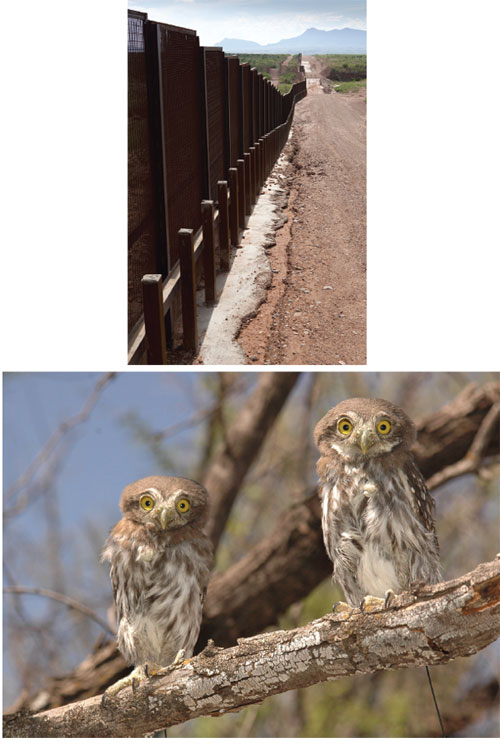Don't Fence Me Out
By Anna Lena Phillips
To protect wildlife, barriers to information flow between science and policy will have to be made more permeable
To protect wildlife, barriers to information flow between science and policy will have to be made more permeable

DOI: 10.1511/2009.81.454
The border between the United States and Mexico traverses nearly 2,000 miles. A barrier that could eventually span its entire length has been under construction since its authorization by the U.S. Congress in 2005. Aaron Flesch, a Ph.D. student at the University of Montana in Missoula, is the lead author of a recent study on the wall’s possible effects on animal populations. “The last thing that border wall’s going to keep out is people,” he says. “The first thing’s wildlife.”

Krista Schlyer (top), Aaron Flesch (bottom)
The study, published in Conservation Biology’s early online view in June, used data from studies of ferruginous pygmy owls (Glaucidium brasilianum) and of desert bighorn sheep (Ovis canadensis mexicana) to try to assess how the two species would react to the barrier. “The Department of Homeland Security really needs to understand quantitatively and precisely what these different structures are going to do to animal movements,” Flesch says.
But that’s easier said than done. “Because of the speed at which the border fence project was funded and started,” notes Clinton Epps, a biologist at Oregon State University and another of the study’s five coauthors, “we really were not able to do a classic sort of pre-post field observation study.” Epps had made a model based on data from GIS mapping and DNA collected from bighorn sheep dung in 27 distinct California populations. To attempt to predict how the sheep move between populations and interbreed, the authors applied this gene-flow model to data that coauthor James Cain, a biologist at Texas A&M University–Commerce, collected on populations in the Sonoran Desert in Arizona. When they simulated a barrier across the study area, the analysis suggested that an impermeable fence would interrupt all of the corridors sheep are likely to use to move between populations along the border.
One might imagine that the owls would have it easier. “Everybody thinks that a bird is going to fly over a wall,” says Flesch. “But it’s not always the case.” Flesch studied pygmy owls in northern Sonora, monitoring their flight and dispersal behavior. He found that owls avoided big vegetation gaps, and juvenile owls had lower colonization success in more-disturbed landscapes. Only 23 percent of owl flights were more than four meters high—the approximate height of border fences. All this could significantly lower the chances that owls would move across the border. The success of populations in Arizona, which are at endangered levels, could depend on the owls’ ability to do so. Indeed, Flesch says, “Both species’ persistence in the region very likely depends upon transboundary movements.”
Matt Clark of Defenders of Wildlife rounded out the study team. Clark helped craft suggestions for mitigation, which include introducing fence gaps in locations where sheep are likely to cross, and designing fences that small animals like owls can move through. The best scenario, the study suggests, would be the use of high-tech solutions, including motion sensors and infrared cameras, rather than physical barriers.
But the legislation surrounding these efforts is more convoluted than the horns of an entire herd of bighorn sheep. Under a provision of the Real ID Act of 2005, the Department of Homeland Security has waived some laws that protect sensitive species and wildlife refuges. DHS has drafted an agreement for monitoring the situation with the Department of the Interior, but as of September, it is in legislative limbo.
Meanwhile, work on the wall continues, and scientists, advocates and concerned government officials continue to try to understand what its effects will be and how to best mitigate them. “As most people realize, international boundaries are not biological boundaries, they’re just political boundaries,” says Flesch. “And, you know, wildlife don’t know the difference.”—Anna Lena Phillips
Click "American Scientist" to access home page
American Scientist Comments and Discussion
To discuss our articles or comment on them, please share them and tag American Scientist on social media platforms. Here are links to our profiles on Twitter, Facebook, and LinkedIn.
If we re-share your post, we will moderate comments/discussion following our comments policy.